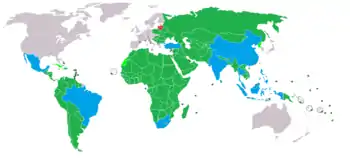کشورهای تازه صنعتیشده
کشورهای تازه صنعتیشده (به انگلیسی: Newly industrialized country) کشورهای در مرحله گذار از درحال توسعه به جامعه صنعتیاند. برای این کشورها اکنون واژه اقتصاد تازه صنعتیشده نیز بکار میرود.

کشورهای تازه صنعتیشده به رنگ آبی، کشورهای درحال توسعه به رنگ سبز و کشورهای توسعهیافته به رنگ خاکستری و قرمز
فهرست
در اینجا فهرستی از کشورهای تازه صنعتیشده براساس شاخصهای مختلف ارائه شدهاست.[1][2][3][4]
یادداشت: خانههای با رنگ سبز بالاترین مقدار یا بهترین عملکرد را در شاخص نشان می دهند ، در حالی که خانههای زرد رنگ نقطه مقابل را نشان میدهند.
| منطقه | کشور | تولید ناخالص داخلی (میلیارد دلار، ۲۰۱۸ صندوق بینالمللی پول)[5] | سرانه تولید ناخالص داخلی (دلار، ۲۰۱۸ صندوق بینالمللی پول)[6] |
تولید ناخالص داخلی (برابری قدرت خرید) (میلیارد دلار، ۲۰۱۸ صندوق بینالمللی پول)[7] | سرانه تولید ناخالص داخلی (برابری قدرت خرید) (دلار، ۲۰۱۸ صندوق بینالمللی پول)[8] |
شاخص جینی ۲۰۱۱–۱۷[9][10] | شاخص توسعه انسانی (۲۰۱۸)[11] | آهنگ رشد واقعی تولید ناخالص داخلی در ۲۰۱۸[12] | منابع |
|---|---|---|---|---|---|---|---|---|---|
| آفریقا | ۳۶۸ | ۶٬۳۷۷ | ۷۹۵ | ۱۳٬۶۷۵ | ۶۳٫۰ (۲۰۱۴) | ۰٫۷۰۵ (بالا) | ۰٫۷۹ | [2][3][4] | |
| آمریکای شمالی | ۱٬۲۲۳ | ۹٬۸۰۷ | ۲٬۵۷۰ | ۲۰٬۶۰۲ | ۴۸٫۳ (۲۰۱۶) | ۰٫۷۶۷ (بالا) | ۱٫۹۹ | [1][2][3] | |
| آمریکای جنوبی | ۲٬۷۵۰ | ۱۳٬۰۸۲ | ۴٬۵۹۳ | ۲۱٬۷۸۱ | ۴۸٫۳ (۲۰۱۷) | ۰٫۸۳۸ (بسیار بالا) | ۴٫۱۱ | [1][2][3] | |
| آسیا | ۱۳٬۴۰۷ | ۹٬۶۰۸ | ۲۵٬۲۷۰ | ۱۸٬۱۱۰ | ۳۸٫۶ (۲۰۱۵) | ۰٫۷۵۸ (بالا) | ۶٫۵۷ | [2][3] | |
| ۲٬۹۷۲ | ۲٬۰۳۶ | ۱۰٬۵۰۵ | ۷٬۸۷۴ | ۳۵٫۷ (۲۰۱۱) | ۰٫۶۴۷ (متوسط) | ۷٫۰۵ | [2][3][4] | ||
| ۱٬۰۲۲ | ۳٬۸۷۱ | ۳٬۴۹۵ | ۱۳٬۲۳۰ | ۳۸٫۱ (۲۰۱۷) | ۰٫۷۰۷ (بالا) | ۵٫۱۷ | [2][3][4] | ||
| ۳۵۴ | ۱۰٬۹۴۲ | ۱٬۰۰۲ | ۳۰٬۸۶۰ | ۴۱٫۰ (۲۰۱۵) | ۰٫۸۰۴ (بسیار بالا) | ۴٫۷۲ | [2][3][4] | ||
| ۳۸۳ | ۳٬۴۸۴ | ۱٬۱۱۰ | ۱۰٬۰۹۴ | ۴۴٫۴ (۲۰۱۵) | ۰٫۷۱۲ (بالا) | ۶٫۲۰ | [1][2][3][4][13] | ||
| ۵۰۵ | ۷٬۴۴۸ | ۱٬۳۱۱ | ۱۹٬۴۷۶ | ۳۶٫۵ (۲۰۱۷) | ۰٫۷۶۵ (بالا) | ۴٫۱۳ | [1][2][3][4] | ||
| اروپا | ۷۶۶ | ۹٬۳۴۶ | ۲٬۳۲۱ | ۲۷٬۹۵۶ | ۴۱٫۹ (۲۰۱۶) | ۰٫۸۰۶ (بسیار بالا) | ۲٫۵۷ | [2][3][4] |
جستارهای وابسته
- Paweł Bożyk (2006). "Newly Industrialized Countries". Globalization and the Transformation of Foreign Economic Policy. Ashgate Publishing, Ltd. p. 164. ISBN 0-7546-4638-6.
- Mauro F. Guillén (2003). "Multinationals, Ideology, and Organized Labor". The Limits of Convergence. Princeton University Press. pp. 126 (Table 5.1). ISBN 0-691-11633-4.
- David Waugh (2000). "Manufacturing industries (chapter 19), World development (chapter 22)". Geography, An Integrated Approach (3rd ed.). Nelson Thornes Ltd. pp. 563, 576–579, 633, and 640. ISBN 0-17-444706-X.
- N. Gregory Mankiw (2007). Principles of Economics (4th ed.). ISBN 0-324-22472-9.
- "World Economic Outlook Database, April 2019". IMF. Retrieved 15 April 2019.
- "World Economic Outlook Database, April 2019". IMF. Retrieved 16 April 2019.
- "World Economic Outlook Database, April 2019". IMF. Retrieved 15 April 2019.
- "World Economic Outlook Database, April 2019". IMF. Retrieved 15 April 2019.
- "GINI Index Data Table". World Bank. Retrieved 4 April 2012.
- Note: The higher the figure, the higher the inequality.
- "Human Development Report 2019 – "Human Development Indices and Indicators"" (PDF). HDRO (Human Development Report Office) United Nations Development Programme. pp. 22–25. Retrieved 9 December 2019.
- "World Economic Outlook Database, April 2019". IMF. Retrieved 16 April 2019.
- https://cnnphilippines.com/news/2019/12/10/undp-human-development-index-2019-philippines.html
This article is issued from Wikipedia. The text is licensed under Creative Commons - Attribution - Sharealike. Additional terms may apply for the media files.